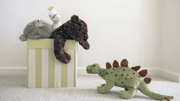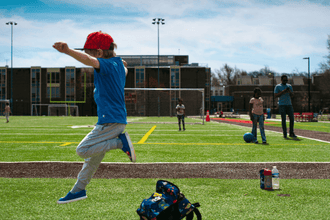
How to Design a Montessori-Inspired Playroom
Introduction:
Creating a playroom for your child is an exciting endeavor, especially when you consider the benefits of incorporating Montessori principles. The Montessori method, developed by Dr. Maria Montessori emphasizes fostering independence, promoting hands-on learning, and respecting a child's natural psychological development. By designing a Montessori-inspired playroom, you're not just creating a space for play—you're building an environment that fosters growth, creativity, and self-confidence.
Understanding the Montessori Philosophy
Before diving into the design, it's essential to understand the core principles of the Montessori approach.
1. Key Montessori Principles
- Independence: Montessori education focuses on empowering children to do things on their own, which nurtures their confidence and decision-making skills.
- Hands-On Learning: This method encourages children to engage directly with their environment, which aids in better learning and retention.
- Respect for the Child: Respecting each child's individuality and pace of learning is crucial in Montessori education.
2. Integrating Montessori Principles into a Playroom
The goal is to create a space that supports these principles, offering children the freedom to explore and learn independently. A well-organized and thoughtfully designed playroom can help achieve this, providing a nurturing environment that promotes both learning and creativity.

Choosing the Right Space
Selecting the right location for your Montessori playroom is an important first step.
- Lighting: Natural lighting is preferred as it creates a warm and inviting atmosphere. If that's not possible, soft, adjustable lighting can help mimic natural conditions.
- Accessibility: Choose a space easily accessible to your child without obstacles, encouraging them to explore freely.
- Safety: Ensure the room is safe by securing furniture to walls and opting for non-toxic materials.
Essential Elements of a Montessori Playroom
Once the space is chosen, focus on incorporating essential elements that align with Montessori principles.
1. Child-Sized Furniture
One of the hallmarks of a Montessori playroom is furniture that caters to the child's size. This includes tables, chairs, and shelves that are at a low height, allowing children to reach and use them independently.
- Tables and Chairs: Choose sturdy yet lightweight options that children can easily move on their own.
- Shelving: Use open, low shelves to enable children to easily view and select their activities. This also encourages tidiness as they learn to put things back in place.
2. Open Shelving and Organization
Organization is key in a Montessori environment. Open shelving not only makes toys and materials accessible but also teaches children about order and categorization.
- Toy Rotation: Keep a selection of toys on display and store the rest. Regularly rotate them to sustain interest and enhance focus.
- Baskets and Bins: Use these for categorizing and storing items, making it easy for children to access and tidy up.
3. Natural Materials
Montessori environments favor natural materials like wood, cotton, and metal over plastic. These materials provide sensory-rich experiences and are more environmentally friendly.
- Wooden Toys: Select simple and durable wooden toys that foster imaginative play.
- Textiles: Use natural fibers for rugs, cushions, and curtains to create a cozy, inviting space.

4. Defined Activity Areas
Create distinct zones for various activities, allowing children to move freely between them and engage in different types of play.
- Art Area: Stock this zone with art supplies like crayons, paper, and paint. Incorporate an easel or a small table to facilitate creative work.
- Reading Nook: Design a cozy corner with a small bookshelf and comfortable seating, inviting children to explore books.
- Building Zone: Provide blocks, construction toys, and mats where children can build and create.
Selecting Montessori-Appropriate Toys and Materials
1. Characteristics of Montessori Toys
Montessori toys are generally simple, purposeful, and age-appropriate, crafted to encourage exploration and learning.
- Simple Designs: Avoid overly complicated or flashy toys. Simplicity allows for greater creativity.
- Purposeful Play: Select toys that serve a clear educational purpose, such as puzzles, stacking toys, and practical life materials.
2. Recommended Toys and Materials
- Infants and Toddlers: Soft blocks, nesting cups, and simple wooden puzzles.
- Preschoolers: Counting beads, shape sorters, and early science kits.
- Elementary Age: More complex puzzles, geography globes, and science experiment kits.
Incorporating Educational Elements
1. Practical Life Activities
These activities help children develop fine motor skills and learn everyday tasks.
- Cleaning Supplies: Provide child-sized brooms, dustpans, and cleaning cloths.
- Cooking Tools: If appropriate, include safe cooking utensils for pretend play or supervised cooking activities.
- Gardening Kits: Simple tools and pots for planting can teach children about nature and responsibility.

2. Language, Math, and Science
- Language: Include alphabet puzzles, flashcards, and simple writing materials.
- Math: Counting beads, number blocks, and measuring tools stimulate mathematical thinking.
- Science: Magnifying glasses, nature kits, and simple experiments foster curiosity about the world.
Creating a Calm and Inviting Atmosphere
A Montessori playroom should be a peaceful retreat that invites exploration.
1. Color and Decor
- Neutral Colors: Use soft, neutral colors for walls and decor to create a calming environment.
- Personal Touches: Include personal items like family photos or your child's artwork to make the space feel unique.
2. Nature Elements
- Plants: Incorporate indoor plants to bring a touch of nature indoors and teach children about plant care.
- Natural Light: Maximize natural light to create a warm, inviting atmosphere.
Encouraging Independence and Responsibility
1. Teaching Organization
- Daily Routines: Establish simple routines for tidying up after play.
- Role-Playing: Use role-playing to teach children how to handle and care for their belongings.
2. Benefits of Responsibility
- Confidence: Children gain confidence as they learn to manage their space.
- Life Skills: Responsibility at an early age translates into valuable life skills later on.
Conclusion
Designing a Montessori-inspired playroom is a rewarding journey that offers countless benefits for your child's development. By creating a space that encourages independence, learning, and creativity, you're nurturing important life skills. Start small, keep observing your child's interests, and adapt the space as needed. With a little effort and imagination, you can transform your child's playtime into an enriching learning experience.









